This Singapore Noodles (aka Singapore Mei Fun) recipe will give you the tastiest takeout style dish in the comfort of your own home. This dry curry noodle dish is made with stir-fried vermicelli noodles, curry powder, shrimp, strips of eggs, char siu, and vegetables.
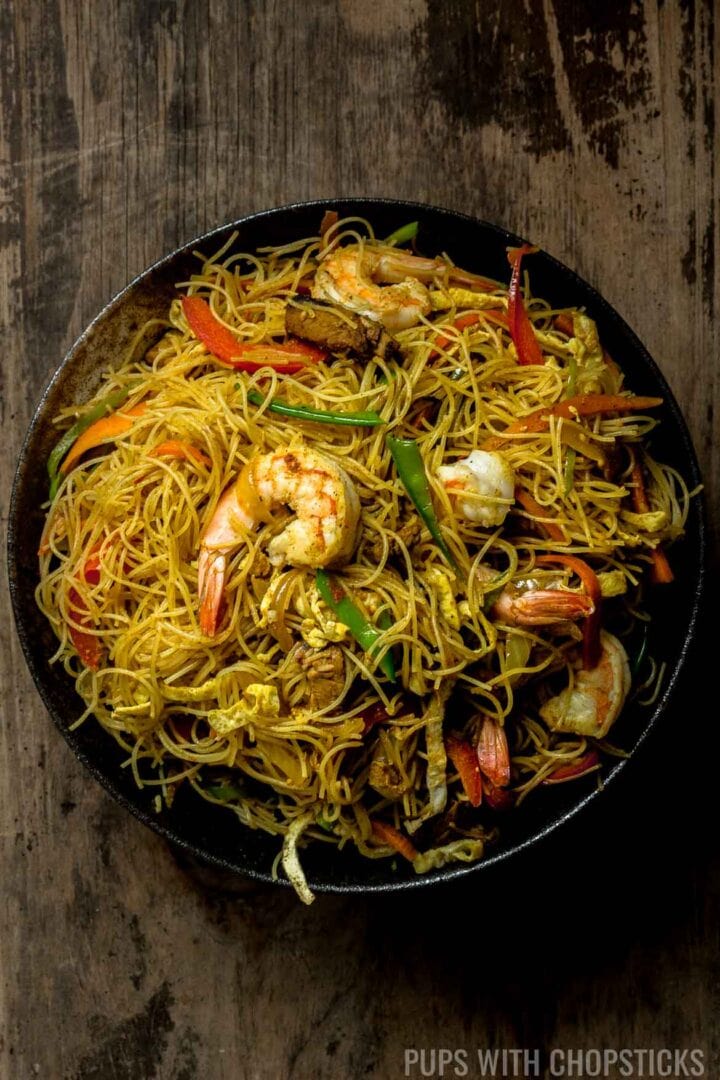
Table of Contents
- What are Singapore Noodles?
- Why You’ll Love This Singapore Noodles Recipe
- Ingredients You’ll Need to Make Singapore Noodles At Home
- What Type of Noodles Do I use for Singapore Noodles?
- How to Make Singapore Noodles (Step by Step)
- Joyce's Tips For Making the Best Singapore Noodles Every Single Time
- Serving Suggestions
- Recipe Variation Ideas for Singapore Noodles
- Frequently Asked Questions
- How to Store Leftover Singapore Noodles
- Looking for More Noodles Recipes? Try these!
- Did you Make This Singapore Noodle Recipe?
- Recipe Card
What’s best is that this is an incredibly easy recipe you can make even if you’ve never tried making a stir-fry before! The key to the best Singapore noodles is all about the perfect balance of ingredients while knowing how to stir fry them properly.
My recipe shares step by step instructions to make it super easy even for beginners. You’ll end up with the tastiest mei fun you’ve ever had that will make you want to cook it every single night!
Plus, it’s a super versatile dish. It can be customized to suit individual tastes and dietary preferences. Whether you prefer a vegetarian version packed with crisp vegetables and tofu, or a meat-lover’s delight with juicy strips of beef or pork, this recipe can be adapted to accommodate any palate.
You can easily make it at home with some simple, pantry staple ingredients that will make you fall in love with stir-fries!
So, if you’re craving a taste of Cantonese street food or simply looking to add a touch of exotic flair to your dinner table, this Singapore noodles recipe is the perfect choice.
Read on to learn exactly how to make delicious Singapore noodles today!
What are Singapore Noodles?
Singapore noodles is a popular dish in Chinese cuisine, but it is not actually from Singapore. It is a stir-fried dish made with thin rice noodles, shrimp, chinese bbq pork, vegetables, strips of eggs, and and a delicious curry sauce. The dish is known for its vibrant flavors and aromatic ingredients.
One of the highlights of Singapore noodles is its versatility as it can easily be customized to suit individual preferences and dietary restrictions. The dish can be made with a variety of proteins such as pork, chicken, beef, or tofu.
Singapore noodles also offers a good balance of flavors and textures. The combination of the tender noodles, crunchy vegetables, and delicious shrimp and bbq pork creates a satisfying and enjoyable eating experience. This noodle dish is typically seasoned with a mixture of soy sauce and curry powder which adds depth and complexity to the dish.
Another reason why Singapore noodles are popular is its quick and easy preparation. It can be whipped up with only 15 minutes of stir-frying, making it a convenient option for busy individuals or families. Plus, it is a great way to use up leftover ingredients, as almost any combination of vegetables and proteins can be used in this dish.
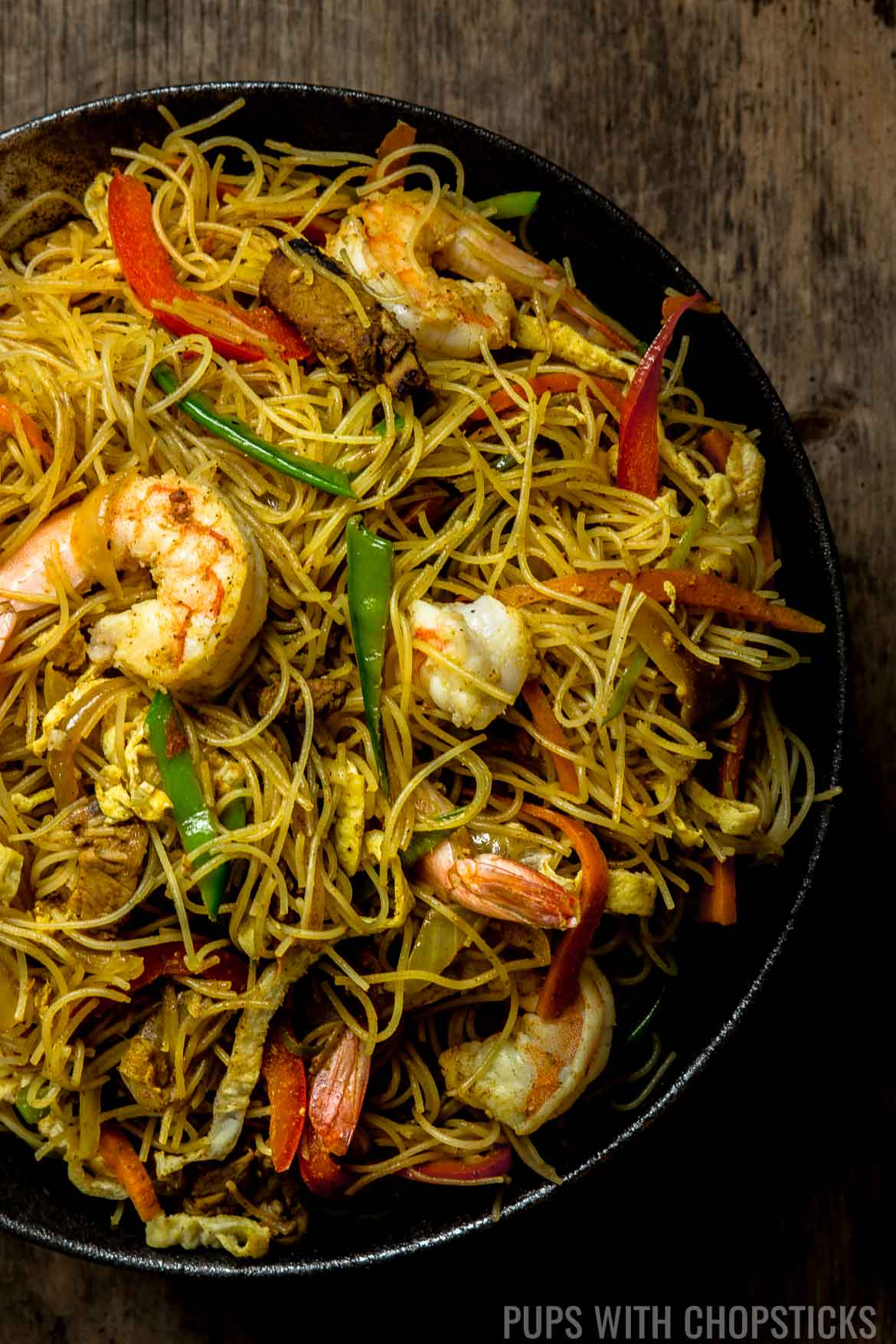
Why You’ll Love This Singapore Noodles Recipe
Authentic: This recipe stays true to the traditional Singapore Noodles flavors, with a perfect balance of curry powder and ingredients to give you the authentic flavor of this popular takeout dish at home.
Easy: With simple instructions and readily available ingredients, this recipe is easy to follow even for beginner cooks. It requires minimal prep work and can be whipped up in no time.
Versatile: This recipe allows for flexibility in terms of ingredients. You can easily customize it to suit your dietary preferences and use a variety of vegetables, proteins, and even add your own twist with additional spices or sauces.
Delicious: The combination of flavors in this recipe creates a mouthwatering dish that is packed with savory, sweet, and spicy notes. The noodles soak up the delicious sauce, making each bite a burst of flavor.
Crowd-Pleaser: Whether you’re cooking for your family or hosting a dinner party, this recipe is a guaranteed crowd-pleaser. The vibrant colors, fragrant aromas, and delicious taste will impress everyone at the table.
Ingredients You’ll Need to Make Singapore Noodles At Home
All you need are some incredibly simple, pantry-staple ingredients to make delicious singapore noodles at home.
Here’s an overview of what you’ll need in this recipe and what it adds to the dish. For the exact measurements, please scroll to the recipe card at the end of this post.
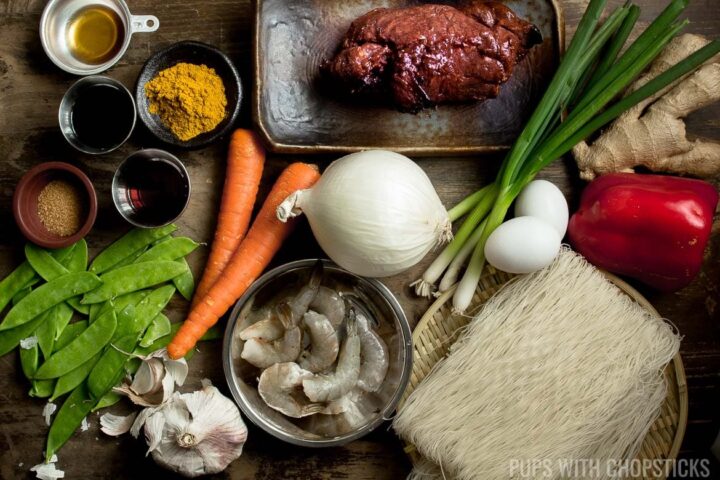
- Vermicelli noodles: They will add a delicate and chewy texture to the dish, absorbing the flavors of the other ingredients as they cook. When you are buying vermicelli noodles, make sure the ingredient list has rice as an ingredient. You also want to buy the thin ones that are 1 mm thick.
Vegetables for Singapore Noodles
- Grated ginger and garlic cloves: The warm and aromatic flavor of the ginger and garlic will give this noodle dish an additional delicious flavor.
- Sweet bell pepper: The vibrant colors and sweet flavor of the bell pepper will add a refreshing and crunchy element to the dish.
- White onion: As it caramelizes in the pan, the onion will release its natural sweetness, enhancing the overall flavor of the dish. You can use yellow onions, but I find white onions have less of a spicy kick.
- Carrot: Using a carrot will help add a subtle sweetness and a vibrant orange color, making the dish visually appealing and flavorful.
- Snow peas: Their crisp texture and fresh taste will provide a nice crunch and a burst of green color to the dish.
- Green onions: The green onions will add a mild onion flavor and a pop of green color, garnishing the dish beautifully.
Meats for Singapore Noodles
- Peeled shrimp: The shrimp will become succulent and tender as they cook, adding a seafood richness to the dish. To make it easier to cook (and eat), we want to make sure the shrimp is peeled. You can pick up shelled shrimp and peel it at home, but I like to buy them frozen and pre-peeled. Make sure the shrimp has fully thawed before using it.
- Chinese BBQ pork: The smoky and sweet flavor of the BBQ pork will complement the other ingredients, adding a delicious depth to the dish. You can buy it from your local Chinese restaurant or find it in larger Asian grocery stores as well. But in case you can’t find it, simply make your own using my Sweet and Sticky Char Siu (Chinese BBQ Pork) recipe!
- Eggs: We’ll be creating some egg ribbons or scrambled eggs and adding it to our singapore noodles for that authentic flavor.
For Curry Sauce
- Madras curry powder: The fragrant spices in the curry powder will create a incredible aroma and add a mild heat giving this dish it’s authentic flavor. If you can't find Madras curry powder (which is usually found online or at Asian grocery stores) you can also use regular standard curry powder as well. Standard curry powder is more yellow, milder in flavor, and less spicy. Madras is more brown, contains a lot more flavorful spices, and is spicier. Not all curry powders are created equal, try to find finely ground curry powders to prevent grittiness to your curry sauce.
- Soy sauce: Adding soy sauce will give a savory umami taste and deepen the overall flavor of the dish. Try getting a good quality soy sauce since it’ll add a lot to the overall dish.
- Fish sauce: The use of fish sauce will provide a unique salty and tangy flavor, enhancing the taste of the other ingredients.
- Shaoxing cooking wine or dry sherry: The wine will add a rich and complex flavor, enhancing the overall taste of the dish and balancing everything out.
- Sugar: We’ll also be using some sugar to balance the flavors, and it’ll add a touch of sweetness and mellow any strong tastes.
- Sesame oil: We’ll be using some sesame oil for this recipe. It’ll add a nutty and aromatic flavor, enhancing the overall taste of the dish.
- Water: Adding water will help to cook and combine all the ingredients, creating a flavorful sauce that coats the noodles and vegetables.
What Type of Noodles Do I use for Singapore Noodles?
When you are looking for vermicelli, make sure you are buying thin rice noodles. The ingredient list on the packaging should have rice or rice flour in it. There are a lot of noodle packages out there that are labeled 'vermicelli' but are actually bean threads (glass noodles/cellophane noodles) that are made with mung beans.
Rice noodles should have an off-white color like in the photo, whereas bean threads are usually very white in color and in smaller bundles.
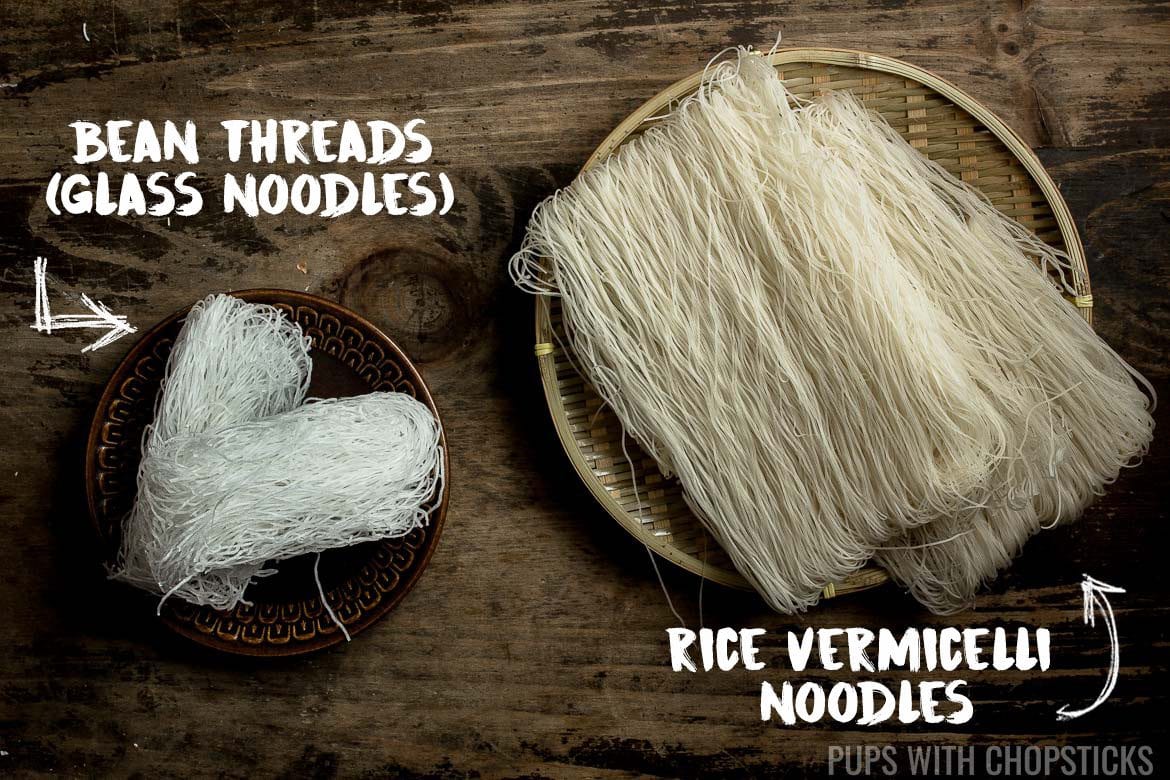
How to Make Singapore Noodles (Step by Step)
Making this incredible Singapore noodles recipe at home is super easy and will give you great results every single time. Here are the detailed instructions for making the curry noodles step by step.
How to Prep Ingredients for Singapore Noodles
To prevent the noodles from becoming mushy, it is important not to boil them before stir-frying. Instead, soak the noodles in hot water (not boiling) for about 2 minutes or until they become soft and flexible.
Slice all the ingredients, such as BBQ pork and vegetables, ahead of time. Peel the shrimp and set it aside for later.
Pre-make the curry sauce by combining all the ingredients listed in the curry sauce section. Set the sauce aside for later use.
How to Make Egg Ribbons
Begin by beating 1 egg well in a bowl until it is fully mixed.
Heat a frying pan and add oil, ensuring that it becomes hot. You can test the temperature by dropping a small amount of egg into the pan. It should sizzle immediately.
Pour the beaten egg into the hot frying pan and swirl it around in a circular motion to create a thin layer, similar to making a crepe. Cook the egg for approximately 1 minute until it is set.
Remove the cooked egg from the pan and repeat steps 1-3 for each additional egg, creating thin egg ribbons. Roll up the cooked eggs into a log shape and thinly slice them. Use your fingers to separate the strands.
Alternatively, instead of making thin egg ribbons, you can scramble the eggs in the pan and set them aside once they are done cooking.
How to Cook Singapore Noodles
In a large frying pan or wok, add a small amount of oil and set the heat to medium.
Once the oil is hot and shimmering, add the ginger, garlic, and shrimp to the pan. Cook for approximately 1 minute until the shrimp turns pink. Remove the shrimp from the pan and set it aside.
Add the BBQ pork and carrots to the pan and cook for about 2-3 minutes until the carrots become wilted.
Add the snow peas, white onions, and peppers to the pan, and cook for an additional 1-2 minutes.
Mix in the soaked noodles, ensuring that all the ingredients are well combined.
Pour the curry sauce into the pan and gently mix everything together. Make sure that all the noodles are coated with the curry sauce. Cook for another 2 minutes or until the noodles are soft and fully cooked.
Add the cooked eggs and green onions to the pan, turn off the heat, and carefully mix everything together until all the ingredients are well incorporated.
Your delicious homemade Singapore Noodles are ready to be served!
Joyce's Tips For Making the Best Singapore Noodles Every Single Time
Madras Curry Powder vs Standard Curry Powder: The main difference between the two is the level of spiciness, flavor, and color. Standard curry powder is more yellow, milder in flavor, and less spicy. Madras is more brown, contains a lot more flavorful spices, and is spicier. If you can't find Madras Curry Powder, substitute it with regular curry powder. If you don't know which one you would like better, start with using standard curry powder, and if you like more flavor, use Madras curry the next time you make it.
Preparation is Key: Before you start cooking, make sure to have all your ingredients prepped and ready to go. This includes slicing the vegetables, meat, and soaking the noodles. This will guarantee a smooth and efficient cooking process.
Use High Heat: When stir-frying the noodles and vegetables, it is important to use medium-high heat. This helps to achieve a nice char and prevents the ingredients from becoming soggy. It also helps to lock in the flavors and create a delicious smoky aroma.
Don’t Overcook the Noodles: Make sure you follow the instructions in this recipe to properly soak the noodles for best results. To prevent mushy noodles, it is crucial that you do not boil the noodles before you stir fry them. You only want to soak them in hot water (not boiling water) for 2 minutes or until they are soft and pliable/flexible.
Add Curry Powder Over Noodles: To get an even coat of curry spread over all the noodles, I like to add my curry powder directly into the sauce so that it spreads all over the ingredients and noodles a lot easier for a more even coating.
Sauce Ratio to Ingredients: It's incredibly important that you use the same amount of ingredients in the recipe card if you are using the sauce ratio I use. If you plan to use less ingredients or omit something (ie, you don't have char siu, or carrots etc.) then reduce the amount of soy sauce or fish sauce to prevent it from being overly salty.
Make Homemade Char Siu: If you don't have Chinese BBQ Pork (Char Siu), you can substitute it with chicken, pork (marinated in soy sauce and garlic) or any type of leftover meats! If you're feeling adventurous, I also have a recipe for Chinese BBQ Pork (Char Siu) on the blog as well!
Garnish with Fresh Herbs: Just before serving, garnish the Singapore noodles with fresh herbs like cilantro or scallions. This adds a pop of color and freshness to the dish. It also enhances the flavors and provides a nice contrast to the savory and spicy noodles.
Serving Suggestions
- Serve the Singapore noodles as a main course as is, or with a side of your favorite stir-fry dish. This dish tastes incredible every single time!
- Create a noodle bowl by serving the singapore noodles with a variety of toppings such as sliced scallions, chopped peanuts, fresh cilantro, and a squeeze of lime. This customizable option allows each person to add their preferred toppings and create a unique and delicious dish.
- Serve the singapore noodles as part of an Asian-inspired buffet or potluck. Pair them with other dishes like spring rolls, dumplings, and fried rice for a diverse and flavorful spread that will please a crowd.
- For a vegetarian option, serve the singapore noodles with crispy tofu or tempeh. The protein-packed tofu or tempeh adds a satisfying texture and makes the dish more filling, while still maintaining the bold flavors of the noodles.
Recipe Variation Ideas for Singapore Noodles
This delicious Singapore noodles recipe is so flavorful and easy to make, giving you authentic flavors at home. But if you’re looking to change things up, here are some great ideas you can try:
Spicy Noodles: Add some red chili flakes or a spicy sauce like sriracha to the stir-fry for an extra kick. This variation is perfect for those who love spicy food and want to add some heat to their noodles.
Vegetarian Noodles: Skip the meat and add more veggies like bell peppers, broccoli, and snap peas to make a delicious vegetarian version. This variation is great for vegetarians or those looking for a lighter, vegetable-packed meal.
Seafood Noodles: Instead of using chicken or pork, use only shrimp, scallops, or a combination of seafood to create a flavorful and seafood-packed dish. This variation is perfect for seafood lovers and adds a unique twist to the traditional recipe.
Peanut Noodles: Add some crushed peanuts to the stir-fry for a nutty twist. This variation is perfect for those who love the combination of peanuts and noodles, adding a rich and delicious flavor to the dish.
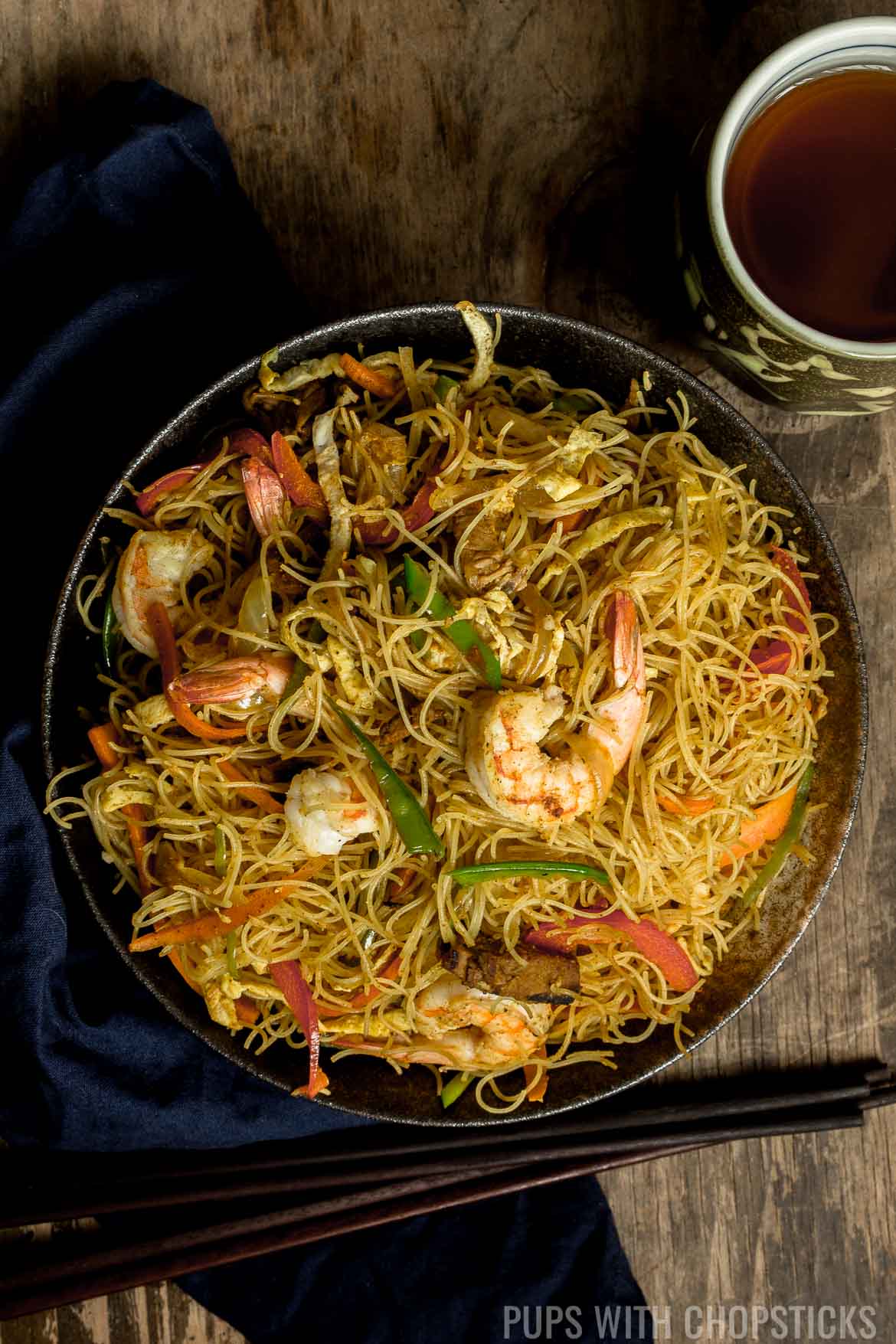
Frequently Asked Questions
What type of noodles do I use to make Singapore Noodles?
When you are looking for vermicelli, make sure you are buying thin rice noodles. The ingredient list on the packaging should have rice or rice flour in it. There are a lot of noodle packages out there that are labeled 'vermicelli' but are actually bean threads (glass noodles/cellophane noodles) that are made with mung beans. Rice noodles should have an off-white color like in the photo, whereas bean threads are usually very white in color and in smaller bundles.
Do Singapore Noodles originate from Singapore?
Interestingly, this dish doesn't actually exist as an authentic local dish in Singapore at all. Singapore noodles (Fried Bee Hoon) in Singapore doesn't actually have curry in it as well! Many say it originated in Malaysia, while other’s claim it’s from Hong Kong. It is common in Cantonese cooking, and a popular takeout dish in the US.
Can I use regular curry powder instead of Madras curry powder?
Yes, you absolutely can. The main difference between regular curry powder and Madras curry powder is the level of spiciness. If you can't find Madras Curry Powder, you can substitute it for regular curry powder as well.
Can I add extra vegetables to this recipe?
Yes, you can add extra vegetables to this recipe to customize it to your liking. Some popular additions include bell peppers, carrots, snap peas, and bean sprouts. Just make sure to adjust the cooking time accordingly to ensure the vegetables are cooked to your desired level of tenderness.
How spicy is this dish?
This dish is overall quite mild, but the spiciness of this dish can vary depending on the type of curry powder you use. My recipe calls for Madras curry powder which is slightly spicier than regular curry powder. You can use either in the recipe depending on the level of spiciness you’re looking for.
How to prevent noodles from turning mushy?
To prevent mushy noodles, it is crucial that you do not boil the noodles before you stir fry them. You only want to soak them in hot water (not boiling water) for 2 minutes or until they are soft and pliable/flexible.
What is the difference between Singapore noodles and chow mein?
The 2 main differences between Singapore noodles and chow mein is the type of noodles and the sauce. Singapore noodles are made with rice vermicelli noodles, chow mein is made with chow mein egg noodles, and Singapore noodles have curry mixed into the sauce whereas chow mein sauce is a simple soy sauce based sauce.
How to Store Leftover Singapore Noodles
To store leftovers of singapore noodles, allow the dish to cool completely before transferring it to an airtight container. Place the container in the refrigerator and consume the leftovers within 2-3 days. When ready to eat, you can reheat the noodles in a pan on the stovetop or in the microwave until heated through.
I don't recommend freezing the leftovers. The noodles may become soggy and lose their texture when thawed and reheated. Plus, some of the vegetables and proteins in the dish may not freeze well and could change in taste and texture when defrosted.
Therefore, it is best to enjoy the Singapore Noodles fresh or consume the leftovers within a few days.
Looking for More Noodles Recipes? Try these!
- Beef Chow Fun (Beef Ho Fun)
- Crispy Cantonese Beef Chow Mein
- Maple Curry Yaki Udon
- Beef & Onion Soy Sauce Noodles
- Japchae (Korean Glass Noodle Stirfry)
- Yum Woon Sen (Thai Glass Noodle Salad)
- Pad Woon Sen (Thai Glass Noodle Stirfry)
- Saucy Beef Ho Fun Noodles with Gravy
- Pad Thai
- Garlic Chili Oil Noodles
- Thai Peanut Noodles
- Longevity Noodles (Yi Mein)
Did you Make This Singapore Noodle Recipe?
If you made this Singapore noodle recipe, I want to see! Follow Pups with Chopsticks on Instagram, snap a photo, and tag and hashtag it with @pupswithchopsticks and #pupswithchopsticks. I love to know what you are making!
Stay connected and follow along on Facebook, Pinterest, and Instagram for all of my latest recipes!
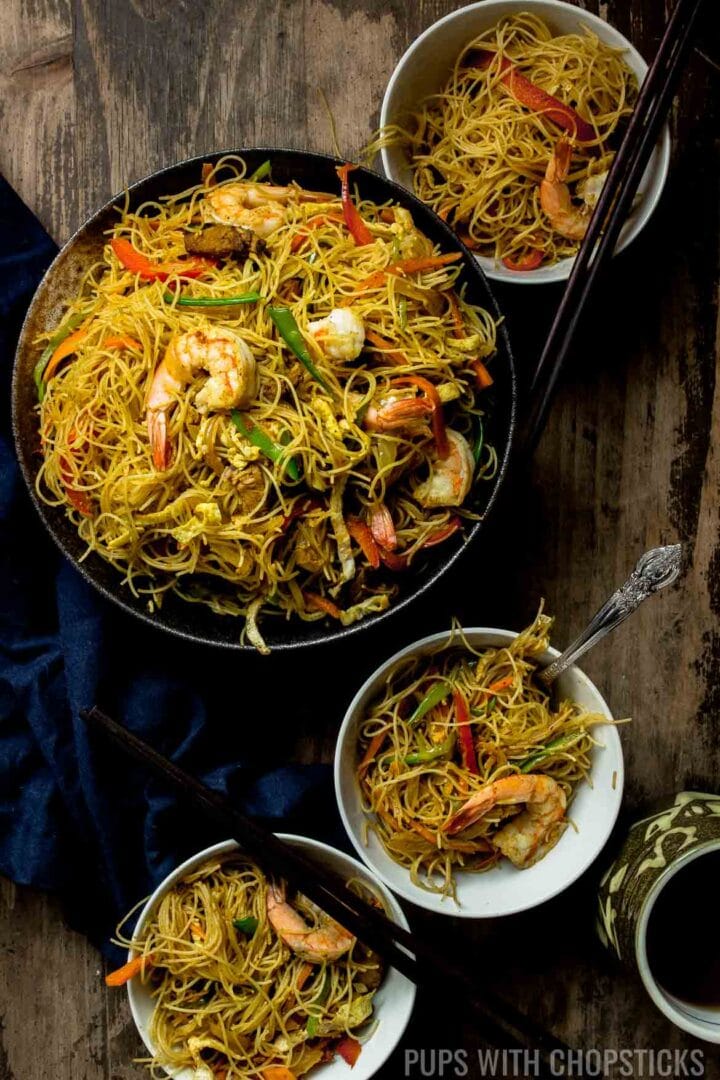
Recipe Card
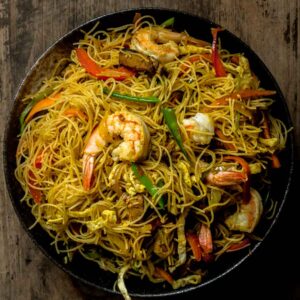
Singapore Noodles
Joyce's Recipe Notes
- Update: I noticed a few people getting mushy noodles with this recipe, and since rice vermicelli can come in different thicknesses, I have adjusted the soak time in the instructions. Just make sure that if you are using very thick vermicelli, the noodles should be pliable after the soak. They should be able to wrap around your finger without snapping or breaking. If it isn't pliable continue to soak it for a few more minutes.
- Sauce Ratio to Ingredients: It's incredibly important that you use the same amount of ingredients in the recipe card if you are using the sauce ratio I use. If you plan to use less ingredients or omit something (ie, you don't have char siu, or carrots etc.) then reduce the amount of soy sauce or fish sauce to prevent it from being overly salty.
- If you don't have Chinese BBQ Pork (Char Siu), you can substitute it with chicken, pork (marinated in soy sauce and garlic) or any type of leftover meats! If you're feeling adventurous, I also have a recipe for Chinese BBQ Pork (Char Siu) on the blog as well!
- Madras Curry Powder vs Standard Curry Powder: The main difference between the two is the level of spiciness, flavor, and color. Standard curry powder is more yellow, milder in flavor, and less spicy. Madras is more brown, contains a lot more flavorful spices, and is spicier. If you can't find Madras Curry Powder, substitute it with regular curry powder. If you don't know which one you would like better, start with using standard curry powder, and if you like more flavor, use Madras curry the next time you make it.
Ingredients
- 225 g rice vermicelli noodles (½ of the pack of 454g, approximately 3 ½ - 4 cups after it has been soaked)
Vegetables
- 2 cm ginger (grated, approximately 2 tablespoons)
- 4 cloves garlic
- ½ sweet bell pepper (any color, sliced, approximately 1 cup)
- ½ white onion (sliced, approximately 1 cup)
- 1 carrot (approximately 1 cup)
- 1 cup snow peas (tips removed, sliced thinly)
- 2 stalks green onions
Meats
- 12 shrimp (peeled, thawed if frozen)
- 1 cup Chinese BBQ pork - char siu (cut into thin strips)
- 2 eggs
Curry Sauce
- 3 tablespoons Madras curry powder
- 3 tablespoons soy sauce (light)
- 3 tablespoons fish sauce
- 1 tablespoon Shaoxing cooking wine (or dry sherry)
- 1 ½ teaspoon sugar
- 1 ½ teaspoon sesame oil
- 6 tablespoons water
Instructions
Preparation
- In a large bowl, add the dry vermicelli noodles and soak them in hot (not boiling) water. Make sure the noodles are fully immersed in water. I usually just use hot tap water for this step. Soak them for about 2 minutes until they are soft and pliable.If you are using thicker rice vermicelli noodles, you may need to soak it for a few more minutes if it isn't pliable after 2 minutes of soak. You should be able to wrap the noodles around your finger without it snapping or breaking.
- Finely grate the ginger and garlic and set aside
- Cut the bell peppers into thin strips and set aside
- Peel and cut the onion into half moon slices and set aside
- Peel and cut the carrots into fine matchsticks and set aside
- Cut the tips from the snow peas off and cut them into thin strips and set aside
- Cut the Chinese BBQ Pork into thin strips and set aside
- Cut the green onions into 2-inch chunks and cut them thinly length-wise. Set this aside to add at the very end when the dish is done cooking.
- If you have shelled shrimp, peel it. If you are using frozen shrimp, make sure it has fully thawed. Set the shrimp aside for later
- Once the noodles are soft, drain the water. (Optional) If they are very long strands of noodles, you can cut them once with scissors to make them easier to stir-fry and eat.
Making Egg Ribbons (or Scrambled Eggs)
- [Note: For Scrambled Eggs Instead] If you want to make simple scrambled eggs instead of egg ribbons, skip the steps 2-7 below in this section and simply beat the eggs together in a bowl and scramble it in a frying pan. Remove from the eggs from the pan and set aside. If you want egg ribbons, then follow steps 2-7 in this section instead.
- In a large frying pan, add a bit of oil and wait for the oil to get hot. To test if the oil is hot enough you can add a drop of egg into it, it should sizzle right away.
- In a bowl, beat 1 egg.
- When the oil is hot, add the egg in and swirl it around the frying pan to create a thin sheet of egg (like a thin crepe). Cook both sides for approximately 1 minute. Remove the egg and set it aside.
- Repeat steps 1-3 for the next egg
- Stack the thin sheets of egg on top of each other and roll it into a log and use a knife to cut it into ¼ inch thick strips (or thinner)
- Use your fingers and gently separate the strips and set it aside to be added at the very end when the dish has finished cooking.
Making the Curry Sauce
- In a bowl, add in all the ingredients listed under 'Curry Sauce' and mix well. Set aside for later.
Putting It Together
- In a large frying pan or wok, add a bit of oil and set the heat to Medium heat
- When the oil is hot and shimmering, add in the ginger, garlic, and shrimp and cook it for approximately 1 minute. Remove the shrimp from the pan and set aside.
- Add in the BBQ pork and carrots and cook until the carrots have wilted approximately 2-3 minutes.
- Add in the snow peas, white onions, and peppers and cook everything for 1-2 minutes.
- Add in the noodles and mix the noodles everything together
- Add the curry sauce into the pan and gently mix everything so that the noodles get a coating of the curry sauce and cook for another 2 minutes or until the noodles are soft and cooked.
- Add in the cooked eggs and green onions, turn off the heat and carefully mix everything together until everything is well mixed
- Enjoy!
Nutrition
*Nutritional information is calculated using online tools and is an estimate*
Disclaimer: We are a participant in the Amazon Services LLC Associates Program, an affiliate advertising program designed to provide a means for us to earn fees by linking to Amazon.com and affiliated sites at no cost to you, however, these links are provided to make items easier if you cannot purchase this locally. Always try to buy your items locally if possible to support your local shops (chances are they are cheaper locally as well too!)

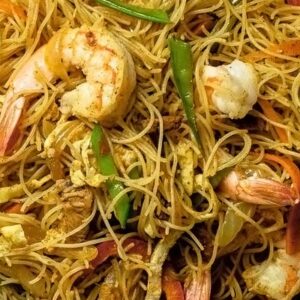
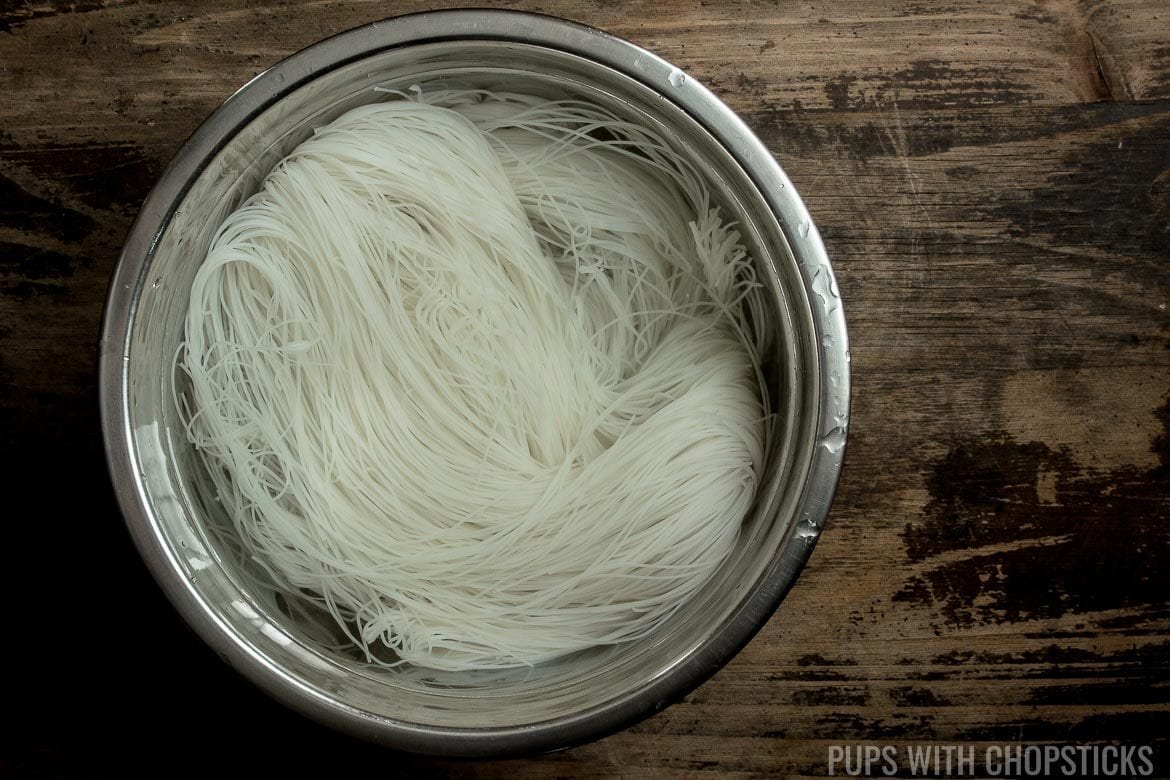
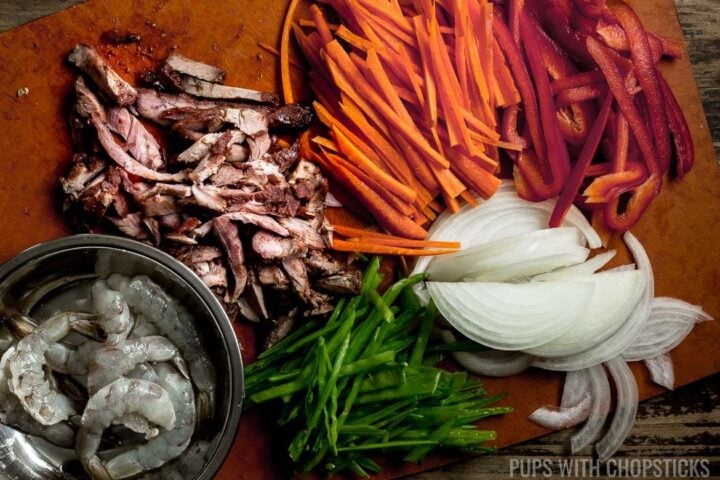
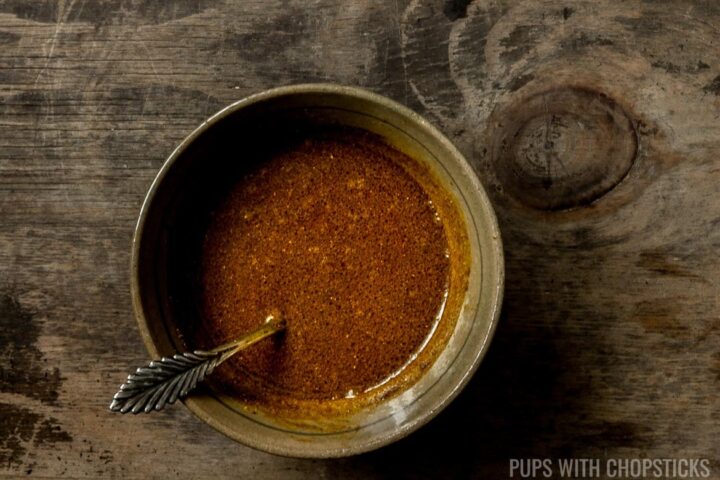
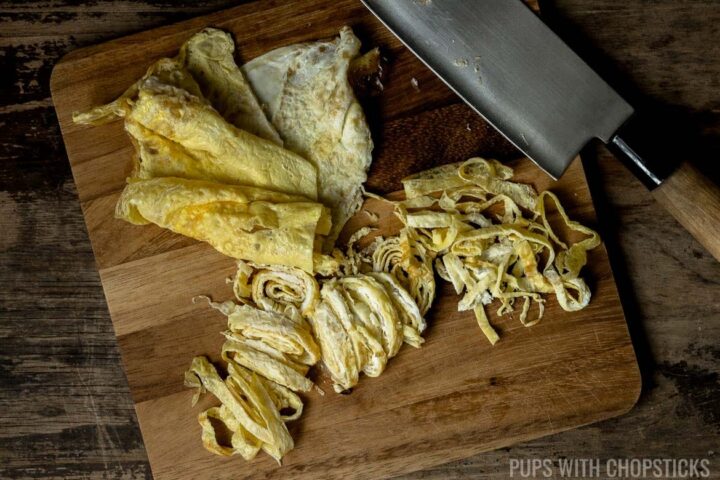
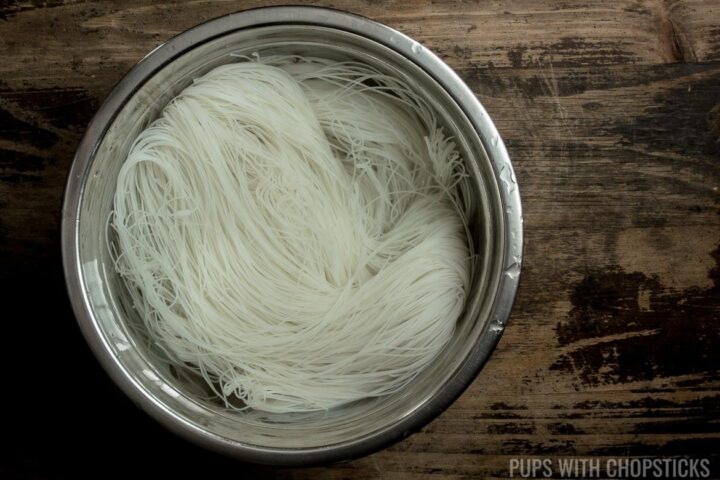
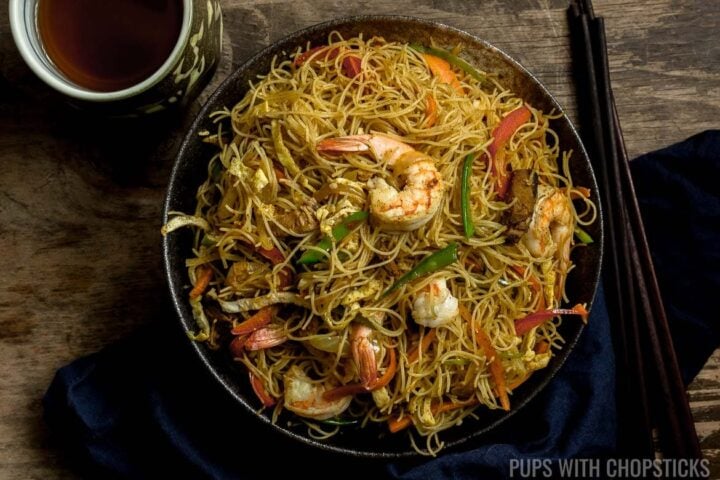
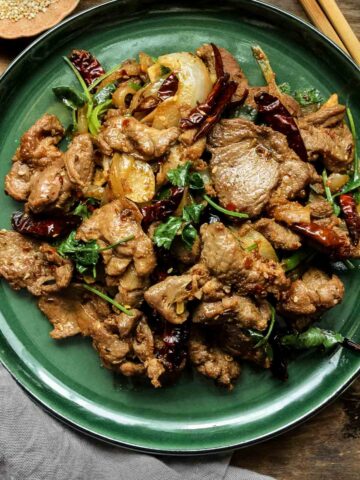
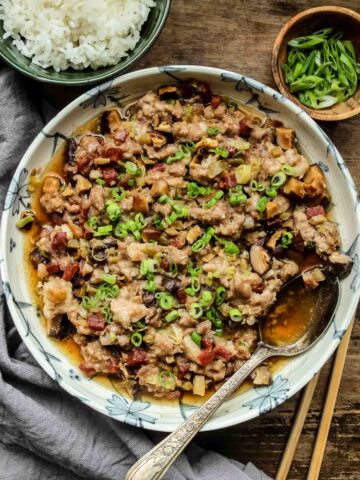
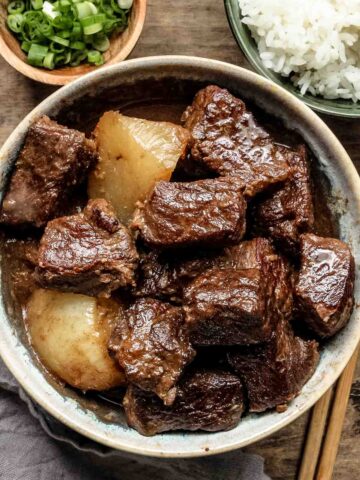
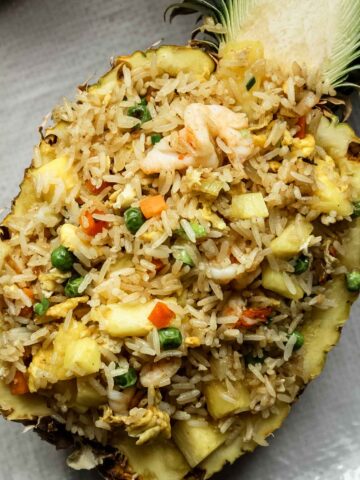
Sue says
Way too salty and the grit from the curry powder is really unpleasant. Singapore Noodles are one of my very favorite dishes but I won’t be making this recipe again.
Joyce Lee says
Hi Sue
I'm really sorry this didn't turn out for you.
Unfortunately, not all curry powders are created equal and depending on the brand, some may be more grittier than others.
Standard curry powder, will have a better chance of it being more finely grounded.
For this recipe, it's incredibly important that you maintain the same amount of ingredients I have in the recipe card because that what I measured the sauce for.
For example, if you omit a few cups of ingredients or use less noodles, then yes it will be salty.
That being said, if anything is omitted or if you're using less ingredients, then you should reduce the amount of soy sauce and fish sauce.
Jossie says
Hi, I followed your instructions and bought the right kind of vermicelli, because this is my favorable noodles that I must have to order this Dish when we dine in a restaurant. Now, I made it successfully with your recipe. My husband was so happy 🥴 thus gave me a thumb-up,👍, and said from now on I can make it tastfully the same without relying to eat same in the restaurants. Thank you Joyce.
Joyce Lee says
Hi Jossie!
I'm so happy you and your husband liked it! It's always nice to make it in the comfort of your home, the portions are larger and it's a lot cozier!